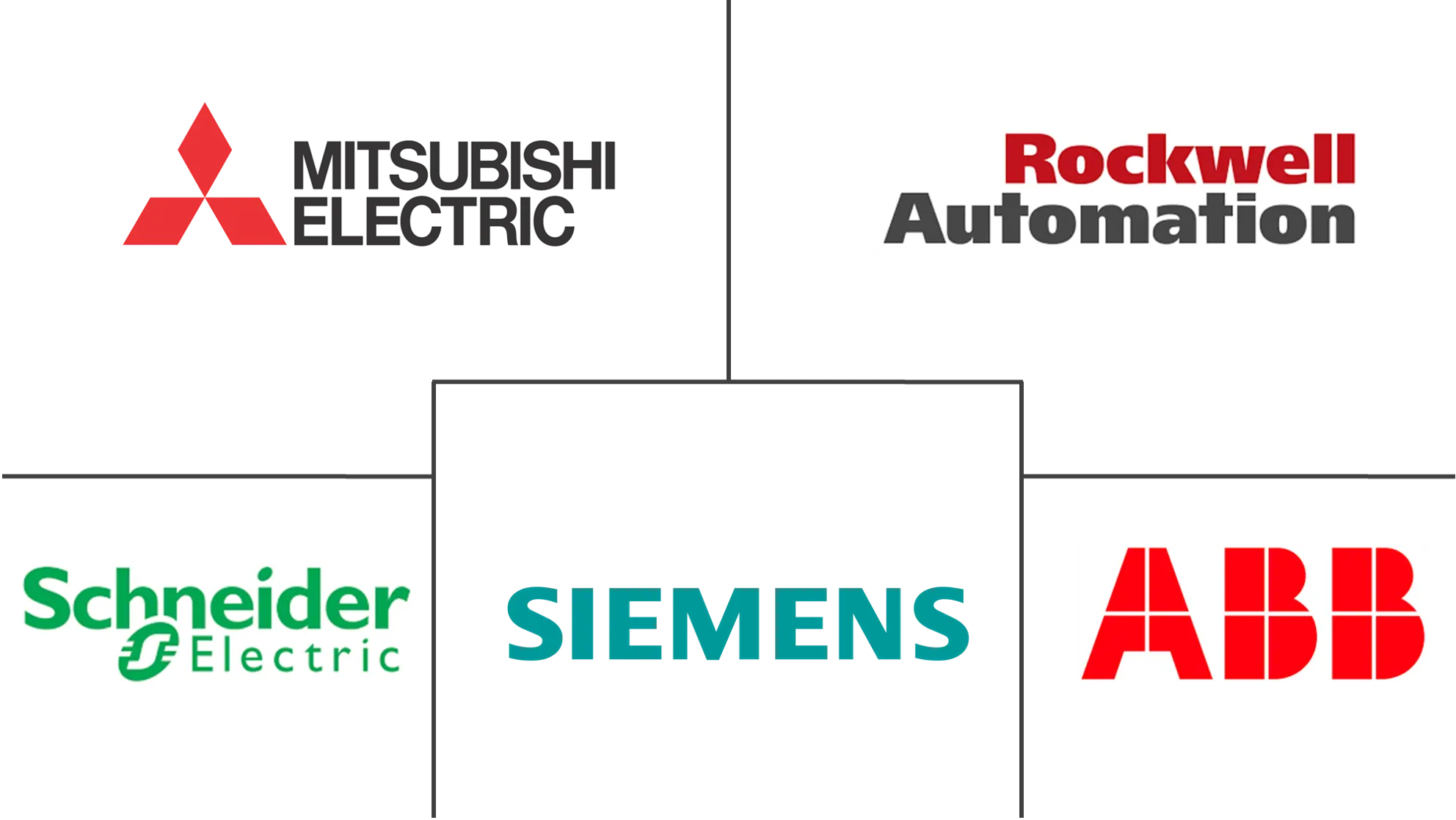Integrated Drive System Market Size and Share
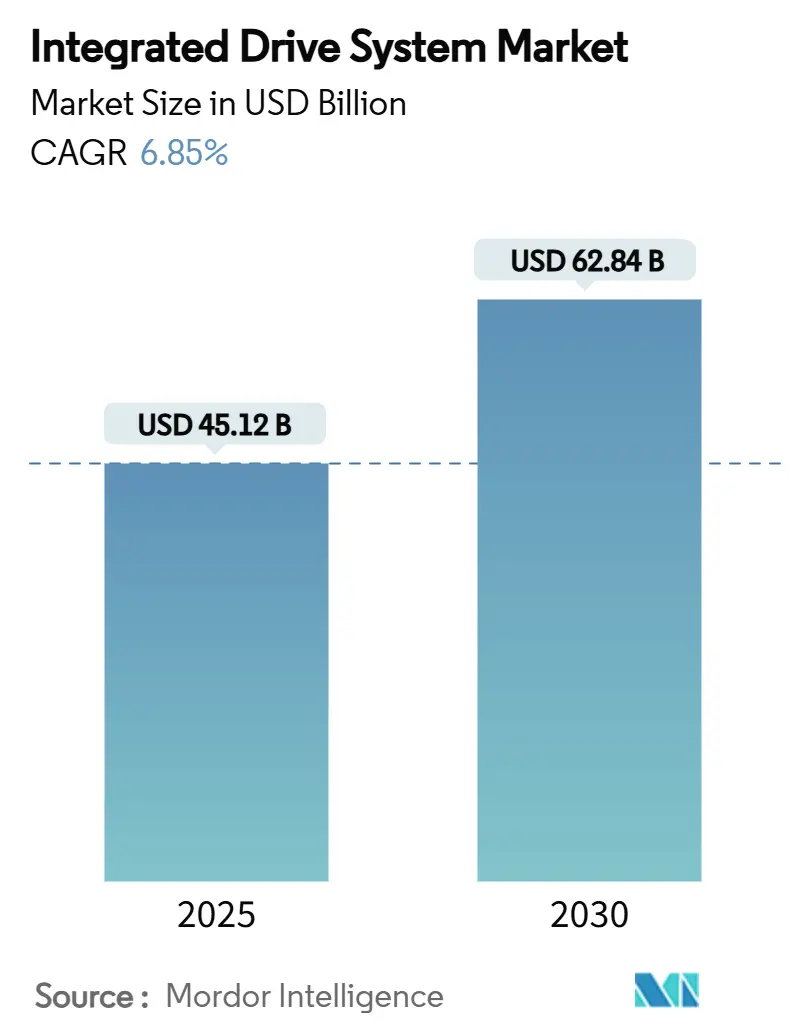
Integrated Drive System Market Analysis by Mordor Intelligence
The integrated drive system market size is valued at USD 45.12 billion in 2025 and is forecast to reach USD 62.84 billion by 2030, advancing at a 6.85% CAGR. Rising digitalization under Industry 4.0 programs, electrification of transport, and tightening global energy-efficiency rules underpin this progression. Demand is reinforced by reshoring‐led factory upgrades in North America, EU IE4 motor mandates, and Asia-Pacific’s automation surge. Manufacturers are choosing integrated power-train packages that lower commissioning time, raise overall equipment effectiveness (OEE), and simplify compliance with system-level efficiency standards. Services linked to predictive maintenance and digital twins are expanding rapidly, reflecting a shift from capital expenditure to outcome-based models. Competitive intensity is moderate because large incumbents combine R&D scale, global footprints, and after-sales reach, although regional challengers in China and South Korea are widening product breadth and pressuring prices.
Key Report Takeaways
- By component, hardware captured 68.0% of integrated drive system market share in 2024; services are projected to expand at 8.8% CAGR to 2030.
- By drive technology, AC drives led with 54.2% revenue share in 2024, while servo/motion drives are forecast to grow at 8.4% CAGR through 2030.
- By power rating, the 10-100 kW band accounted for 38.5% share of the integrated drive system market size in 2024; the <1 kW segment is advancing at 7.7% CAGR to 2030.
- By end-user, automotive dominated with 27.4% market share in 2024; pharmaceuticals register the fastest 8.1% CAGR to 2030.
- By geography, Asia-Pacific held 41.0% of the integrated drive system market in 2024 and is progressing at 8.9% CAGR through 2030.
Global Integrated Drive System Market Trends and Insights
Drivers Impact Analysis
| Driver | (~) % Impact on CAGR Forecast | Geographic Relevance | Impact Timeline |
|---|---|---|---|
| Shift toward Industry 4.0 and energy-efficiency mandates | +1.2% | EU, China, global spillover | Medium term (2-4 years) |
| Demand for higher OEE and reduced unplanned downtime | +0.9% | North America, EU, APAC | Short term (≤ 2 years) |
| EV power-train electrification pulling integrated e-drives | +1.5% | China, EU, North America | Long term (≥ 4 years) |
| Automation boom in emerging economies | +1.1% | APAC core, LatAm, MEA | Medium term (2-4 years) |
| Embedded edge-AI enabling predictive maintenance | +0.8% | North America, EU, APAC | Medium term (2-4 years) |
| “Plug-and-produce” modular drive cabinets | +0.7% | Global manufacturing centers | Short term (≤ 2 years) |
| Source: Mordor Intelligence | |||
Shift toward Industry 4.0 and energy-efficiency mandates
Industry 4.0 roadmaps and the EU’s IE4 motor rules for 75-200 kW classes compel factories to judge complete power-drive systems rather than standalone motors. IEC 61800-9-2 classifications reinforce this trend by rating system performance. Manufacturers targeting carbon reductions increasingly retrofit drives that harvest low-grade waste heat or integrate organic Rankine cycle units, a priority for the US industrial base that generates 1,180 TBtu of such heat yearly. China’s automotive semiconductor standards program covering 30 device types by 2025 bolsters local drive-system ecosystems. AI-enabled analytics embedded in drives allow operators to meet regulatory efficiency thresholds while improving throughput, enhancing the business case for fully integrated solutions.
Demand for higher OEE and reduced unplanned downtime
Unplanned stoppages cost energy-intensive US manufacturers close to USD 50 billion each year. [1]MDPI, “Predictive maintenance in energy-intensive industries,” mdpi.comIntegrated drives with built-in vibration, thermal, and current-signature diagnostics cut troubleshooting time and lift asset availability. ABB’s Trendex cloud tool for gearless mill drives halves fault-finding latency in hard-rock mining applications. In heavy metals processing, a Siemens SINAMICS upgrade boosted Century Aluminum’s uptime by more than 50% and added 300,000 pounds daily output. Edge-AI sensor modules such as TDK’s i3 Micro reduce cabling, accelerating predictive-maintenance rollouts. As OEE gains translate directly into EBITDA, senior operations leaders increasingly prioritize retrofit programs that centralize motor, inverter, and analytics into a single enclosure.
EV power-train electrification pulling integrated e-drives
OEM demand for compact e-axles drives the integrated drive system market as higher voltage architectures enter series production. ZF’s EVSys800 unit unites motor, inverter, and gearbox in a 74 kg package delivering 800 V continuous operation and 276 hp. AISIN’s Xin1 project targets a 50% volume cut for second-generation e-axles by 2025, anticipating tighter under-body space and cost ceilings. Korea’s Special Act on Future Vehicles, aiming for 4.5 million zero-emission vehicles on the road by 2030, anchors local sourcing mandates that favor drive suppliers with regional manufacturing. [2]Invest Korea, “Korea's future vehicle initiatives,” investkorea.orgIntegrated regenerative-braking logic can extend driving range 15-20%, a competitive differentiator in markets with sparse charging grids. Suppliers that combine silicon-carbide inverters, magnet-reduced motors, and software-defined energy-management stand to capture higher vehicle content value.
Automation boom in emerging economies
Asia-Pacific represented USD 6.6 billion in industrial robot sales during 2022, triple Germany’s volume, signalling a structural rise in drive-system penetration. Chinese conglomerates such as Midea and Inovance offer price-competitive integrated packages, squeezing global incumbents’ margins. South Korea’s domestic CNC drive initiatives further erode import share previously held by Japanese suppliers. Food and beverage sites adopt modular drives to automate repetitive palletizing under hygiene constraints. [3]OMRON, "Food and beverage industry solutions," industrial.omron.euIncremental automation financed via operating leases lowers capex barriers for SMEs, broadening the addressable base of the integrated drive system market.
Restraints Impact Analysis
| Restraint | (~) % Impact on CAGR Forecast | Geographic Relevance | Impact Timeline |
|---|---|---|---|
| High capex and lifecycle complexity | -0.8% | Global SMEs, emerging markets | Medium term (2-4 years) |
| Inter-vendor interoperability gaps | -0.6% | Mixed-vendor plants worldwide | Short term (≤ 2 years) |
| Cyber-security attack-surface expansion | -0.5% | North America, EU | Medium term (2-4 years) |
| Scarcity of commissioning talent | -0.4% | APAC, LatAm | Long term (≥ 4 years) |
| Source: Mordor Intelligence | |||
High capex and lifecycle complexity
Integrated packages cost more upfront than discrete components, sometimes doubling project budgets for SMEs. Total ownership extends to engineering, training, and security patches that may equal two to three times hardware outlay across life-cycles. Financing hurdles loom largest in emerging economies where interest rates elevate payback thresholds. Complexity of root-cause analysis inside multi-function enclosures can prolong downtime because specialized diagnostic tools and parts are needed. Executives therefore stage investments or negotiate service-inclusive contracts to smooth cashflow.
Inter-vendor interoperability gaps
Proprietary fieldbuses and data models complicate system expansion in brownfield facilities. Custom gateways can add 25-30% to integration costs, undermining energy savings targets. Lack of standardized predictive-maintenance formats also restricts analytics rollouts across mixed fleets. Industry alliances continue to push for open interfaces, yet adoption varies, prolonging uncertainty for buyers budgeting ten-year asset lives.
Segment Analysis
By Component: Hardware Dominance with Services Acceleration
Hardware secured 68.0% of the integrated drive system market share in 2024 as motors, inverters, and gearsets form the capital backbone of automation lines. Services, however, outpace all other categories, recording an 8.8% CAGR to 2030 on rising demand for predictive maintenance and digital-twin optimization contracts. Hardware vendors bundle analytics software to protect installed bases and to convert transactional sales into lifecycle revenue streams.
The services upswing mirrors customer focus on uptime and energy-per-unit metrics. Mining groups adopting ABB fleet-management dashboards cut unscheduled stoppages and improve safety through shared real-time diagnostics. OEMs leverage cloud APIs to monetize motor health data, while smaller plants take subscription tiers that avoid large capital outlays. Those dynamics reposition services as a strategic wedge for differentiation within the integrated drive system market.
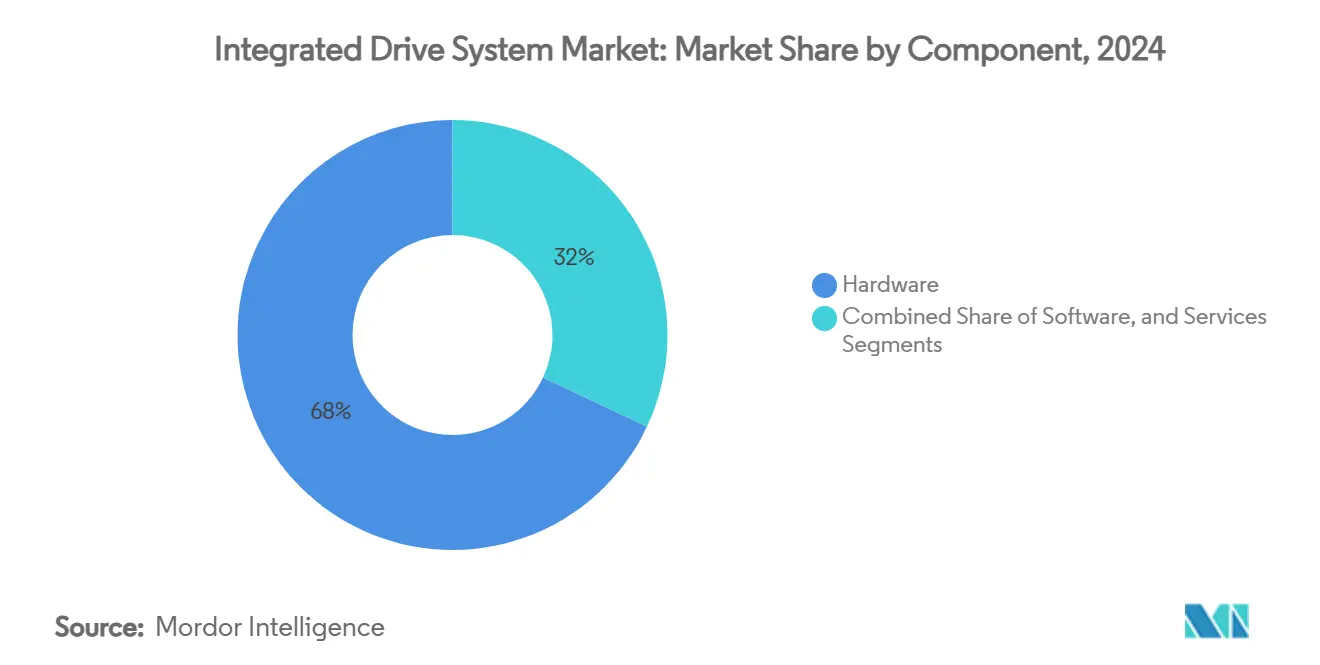
Note: Segment shares of all individual segments available upon report purchase
By Drive Technology: AC Drives Lead with Servo Systems Surging
AC platforms delivered 54.2% of revenue in 2024 thanks to versatility and mature supply chains that lower price per kilowatt. Servo and motion-centric packages, though smaller, log an 8.4% CAGR to 2030, boosted by robotics, additive manufacturing, and precision packaging lines that need sub-millimeter repeatability.
Siemens’ collaboration with robot OEMs streamlines servo integration, allowing unified programming of multi-axis cells. Silicon-carbide switches cut thermal losses, helping servo drives move into higher duty cycles once limited to AC variants. Rising cobot adoption in consumer-goods plants accelerates this shift, setting the stage for servo solutions to chip away at entrenched AC positions within the integrated drive system market size for motion-intensive tasks.
By Power Rating: Mid-Range Dominance with Micro-Drive Growth
Machines rated 10-100 kW accounted for 38.5% of integrated drive system market size in 2024, reflecting heavy use across pumps, blowers, and conveyors. Growth momentum now sits with <1 kW micro-drives at 7.7% CAGR, enabled by smart sensors and distributed control that favor small, networked actuators.
TDK’s ultra-compact modules integrate sensing, compute, and wireless in fist-sized footprints, ideal for mobile robotics. Warehouse automation and automated guided vehicles deploy dozens of low-power drives per site, scaling volume quickly. At the other end, >100 kW high-power units remain essential for compressors and rolling mills but grow modestly because of capital intensity.
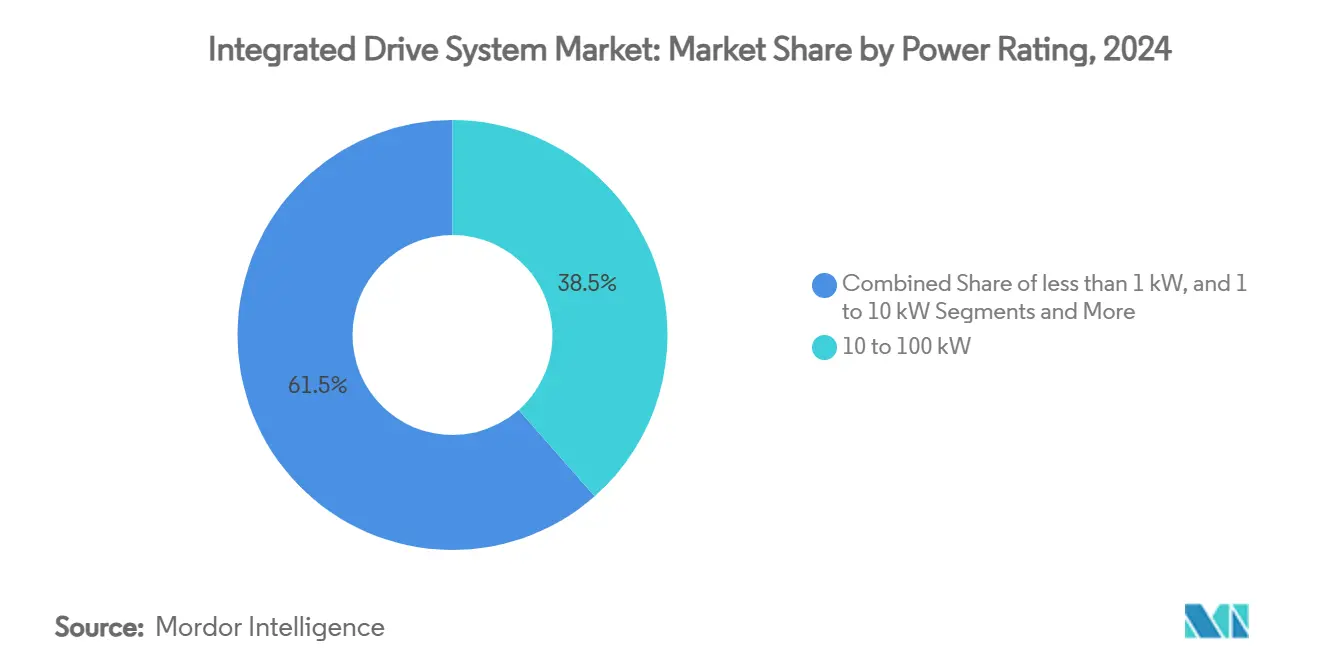
Note: Segment shares of all individual segments available upon report purchase
By End-user Industry: Automotive Leadership with Pharmaceutical Momentum
Automotive plants held 27.4% share in 2024, dominated by paint shops, body-in-white lines, and e-axle production cells that favor tightly integrated motor-inverter sets. Pharmaceuticals top the growth league with an 8.1% CAGR, propelled by stringent validation requirements and the shift to personalized medicine batches that need flexible motion profiles.
ISPE studies show single-use bioreactors and continuous manufacturing lines rely on servo drives for sterility-preserving changeovers.[4]ISPE, “Industry 4.0 in pharmaceutical manufacturing,” ispe.org Food-grade stainless housings and IP69K ratings spill over from pharma to food and beverage, enlarging the addressable segment. Mining, metals, and water utilities sustain baseline demand through energy-retrofit mandates, reinforcing a diversified revenue mix across the integrated drive system market.
Geography Analysis
Asia-Pacific commanded 41.0% of integrated drive system market share in 2024 and advances at 8.9% CAGR, lifted by China’s robotics density targets and South Korea’s domestic CNC programs. Government incentives outlined in China’s 14th Five-Year Plan double robot penetration by 2025, securing long run visibility for drive orders. South Korea’s home-grown precision drives reduce reliance on imports and foster export capabilities. Japan’s semiconductor renaissance revitalizes demand for nanometer-accurate motion axes in lithography and packaging.
North America ranks second by revenue as reshoring, asset life extension, and federal motor-efficiency standards encourage upgrades. ABB’s USD 100 million Wisconsin campus underscores supplier commitment to regional manufacturing and shorter supply chains. CISA advisories elevate cybersecurity to board-level priority, accelerating purchases of drives with secure-boot and encrypted communications. Waste-heat recovery retrofits in heavy industry add incremental demand for high-efficiency power stages.
Europe’s pathway is framed by binding IE4 motor regulations and ecodesign rules aiming to cut fan electricity use by 31 TWh annually. Siemens posted record EPS of EUR 10.54 (USD 11.3) in Q4 2024, highlighting robust automation demand. The region’s renewable push stimulates orders for HVDC converter drives and offshore-wind auxiliary systems. Emerging markets in Middle East, Africa, and Latin America adopt integrated drives in mining and infrastructure, progressing from pilot to scaled deployments as financing instruments mature.
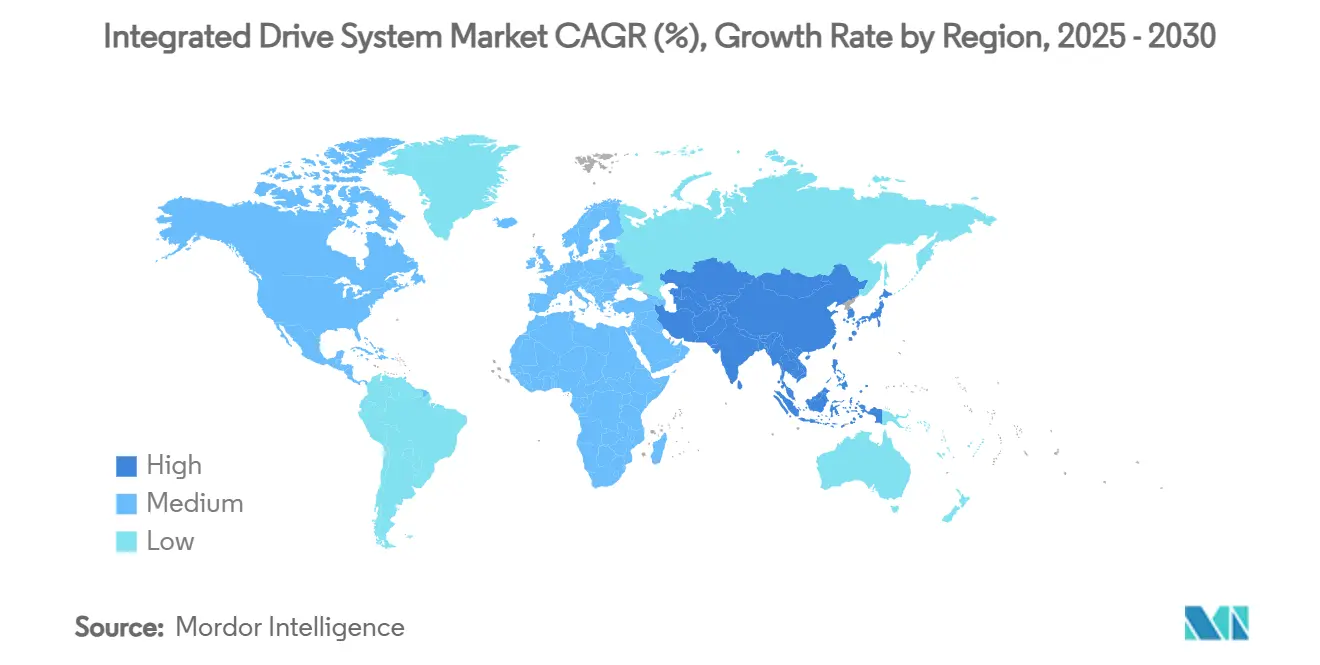
Competitive Landscape
The integrated drive system market shows moderate consolidation. Top suppliers command sizable installed bases, yet their combined share remains below oligopoly thresholds as regional entrants scale. ABB expanded domestic capacity with the Wisconsin plant while acquiring Gamesa Electric’s 40 GW converter portfolio, strengthening renewable conversion depth. Siemens bought ebm-papst’s industrial-drive unit, adding battery-powered modules for mobile robots, a fast-growing niche. Schneider Electric’s Motivair deal enhances liquid-cooling know-how for data-center applications, broadening thermal-management solutions.
Chinese vendors leverage home-market scale, state incentives, and competitive pricing to erode share in mid-range power classes. Their rise pressures Western manufacturers to differentiate through software, cybersecurity, and domain services. Intellectual-property filings around magnet arrays and cooling channels illustrate ongoing innovation in core electromechanics.
Cybersecurity robustness is a new battleground. Vendors integrate IEC 62443 compliance and real-time anomaly detection within firmware to reassure risk-averse buyers. Service models evolve toward outcome-based contracts where suppliers guarantee availability or energy savings, tilting competition toward those with data analytics capabilities and global field teams. White-space opportunities persist in validated pharma systems and food-grade sealed drives, segments with high regulatory barriers that niche players can exploit.
Integrated Drive System Industry Leaders
-
ABB Ltd.
-
Schneider Electric SE
-
Siemens AG
-
Rockwell Automation, Inc.
-
Mitsubishi Electric Corporation
- *Disclaimer: Major Players sorted in no particular order
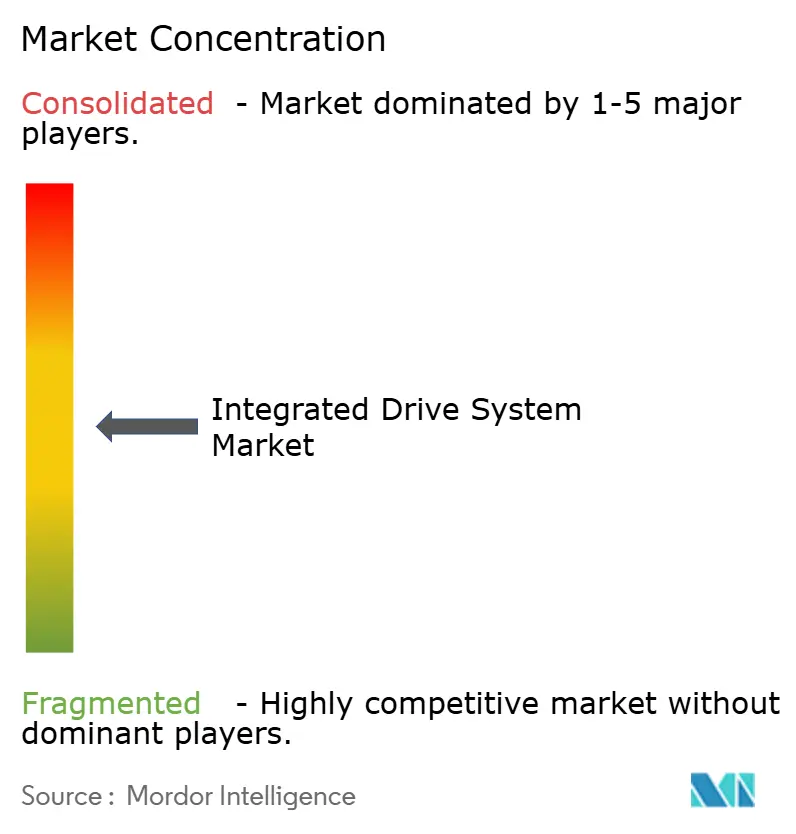
Recent Industry Developments
- February 2025: ABB published its Annual Reporting Suite 2024, citing a 78% scope 1-2 emissions cut since 2019 and 66 megatons of customer emissions avoided, reinforcing sustainability positioning.
- February 2025: Schneider Electric posted EUR 9.3 billion (USD 10.0 billion) Q3 2024 revenues, with the Systems division, including integrated drives, rising 19% organically on data-center momentum.
- December 2024: ABB agreed to buy Gamesa Electric’s power-electronics arm, adding 40 GW of installed converters and deepening renewable-power offerings.
- December 2024: Sulzer introduced VoltaSplit electrified distillation, promising up to 90% CO2 cut versus steam boilers by substituting all heat with electricity.
Global Integrated Drive System Market Report Scope
Integrated drive systems are used to improve the efficiency of industrial production in optimizing the functions of components, like gears and motors. The increasing need for energy conservation is leading to the higher adoption of integrated drive systems among end-user industries. The market has been analyzed by segmenting it into hardware and software on the basis of offering and their subsequent application in the various end- user industries.
| Hardware |
| Software |
| Services |
| AC Integrated Drives |
| DC Integrated Drives |
| Servo / Motion Integrated Drives |
| Variable-Frequency Integrated Drives |
| < 1 kW |
| 1 – 10 kW |
| 10 – 100 kW |
| > 100 kW |
| Automotive |
| Oil and Gas |
| Food and Beverage |
| Mining and Metals |
| Pharmaceutical |
| Chemical |
| Water and Waste-water |
| Others (Pulp and Paper, Textiles, etc.) |
| North America | United States |
| Canada | |
| Mexico | |
| South America | Brazil |
| Argentina | |
| Rest of South America | |
| Europe | Germany |
| United Kingdom | |
| France | |
| Italy | |
| Spain | |
| Russia | |
| Rest of Europe | |
| Asia Pacific | China |
| Japan | |
| South Korea | |
| India | |
| ASEAN | |
| Oceania | |
| Rest of Asia Pacific | |
| Middle East and Africa | GCC |
| Turkey | |
| South Africa | |
| Rest of Middle East and Africa |
| By Component | Hardware | |
| Software | ||
| Services | ||
| By Drive Technology | AC Integrated Drives | |
| DC Integrated Drives | ||
| Servo / Motion Integrated Drives | ||
| Variable-Frequency Integrated Drives | ||
| By Power Rating | < 1 kW | |
| 1 – 10 kW | ||
| 10 – 100 kW | ||
| > 100 kW | ||
| By End-user Industry | Automotive | |
| Oil and Gas | ||
| Food and Beverage | ||
| Mining and Metals | ||
| Pharmaceutical | ||
| Chemical | ||
| Water and Waste-water | ||
| Others (Pulp and Paper, Textiles, etc.) | ||
| By Geography | North America | United States |
| Canada | ||
| Mexico | ||
| South America | Brazil | |
| Argentina | ||
| Rest of South America | ||
| Europe | Germany | |
| United Kingdom | ||
| France | ||
| Italy | ||
| Spain | ||
| Russia | ||
| Rest of Europe | ||
| Asia Pacific | China | |
| Japan | ||
| South Korea | ||
| India | ||
| ASEAN | ||
| Oceania | ||
| Rest of Asia Pacific | ||
| Middle East and Africa | GCC | |
| Turkey | ||
| South Africa | ||
| Rest of Middle East and Africa | ||
Key Questions Answered in the Report
What is the current size of the integrated drive system market?
The market stands at USD 45.12 billion in 2025 and is projected to reach USD 62.84 billion by 2030, exhibiting a 6.85% CAGR.
Which component category is growing fastest?
Services, including predictive-maintenance and digital-twin offerings, post the quickest 8.8% CAGR through 2030 as manufacturers seek uptime guarantees.
Why is Asia-Pacific the largest regional market?
China’s robotics density targets, South Korea’s domestic CNC programs, and Japan’s semiconductor investments collectively drive 41.0% share and the fastest 8.9% CAGR in the region.
How do integrated drives support electric vehicles?
Integrated e-axles merge motors, inverters, and gear-sets to save space, cut weight, and enable 15-20% range extension via regenerative-braking logic, strengthening EV power-train efficiency.
What are the main restraints to adoption?
High capex, interoperability issues, cybersecurity risks, and a shortage of commissioning talent together trim the forecast CAGR by approximately 2.3 percentage points.
Page last updated on:
